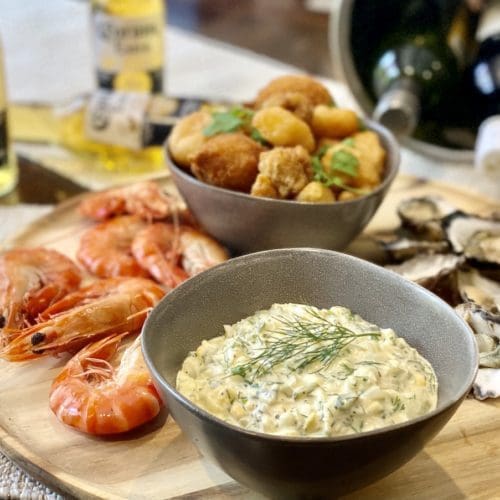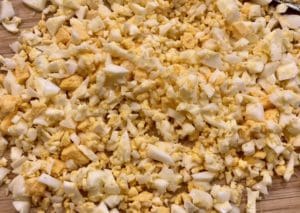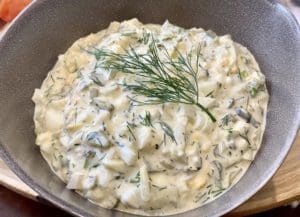
JAPANESE TARTAR SAUCE
If you're a fan of tartar sauce, then you're going to fall madly in love with this rich and chunky Japanese Tartar Sauce
Video
Ingredients
- 3 large eggs (approx.58g / 2oz each)
- water and ice cubes
- ½ cup (125ml / 4.5oz) Kewpie, Japanese Mayonnaise (or whole egg mayonnaise) (NOTE 1)
- 2 tsp horseradish cream (NOTE 2)
- 2 tsp lemon juice
- 50g / 1.8oz) baby cucumber pickles (finely chopped) (NOTE 3)
- 45g / 1.6oz brown onion (or 1/2 a small onion, finely chopped)
- 2 tsp fresh parsley (finely chopped)
- 2 tsp fresh dill (finely chopped) (NOTE 4)
- Salt and pepper (to taste)
Instructions
- Place enough water in a saucepan to cover the eggs by at least 1in / 2.5cm. Bring the water to a boil over high heat, then reduce to low. Carefully lower the eggs into the water using a slotted spoon or spider strainer. Return to a boil over high heat, then lower it to medium-high to prevent the eggs from bouncing. Boil the eggs for 12 to 13 minutes. Prepare a water bath with ice for the eggs in a large bowl. Ensure that there is enough water to cover the eggs completely. Once the eggs are done, quickly transfer them into the water bath and leave to cool for 10 minutes.Peel and roughly chop the eggs, remembering that the finer the chop, the less chunky the sauce will be.

- Place the chopped eggs into a large bowl, then add in the remaining ingredients. Combine the ingredients gently, then have a taste and add salt and pepper to your liking.

Notes
(NOTE 1) Japanese Mayonnaise - Japan's famous mayonnaise brand is Kewpie. Unlike regular mayonnaise, which uses whole eggs, Kewpie uses only yolks, giving it a richer, fattier texture. You could swap for good quality whole egg mayonnaise. I make do with whatever's available in my pantry or fridge.
(NOTE 2) Horseradish cream - Traditionally Japanese mustard is used in this tartar sauce, but I swapped for horseradish cream as it's readily available. You could swap horseradish cream for equal amounts of wasabi paste.
(NOTE 3) Pickles - I love using pickled cornichons or baby cucumbers because they're more crisp and mild in taste than regular pickles. However, you could just use regular pickles or gherkins.
(NOTE 4) Dill - optional - Dill is not a typical ingredient in Japanese tartar sauce, but I added for extra freshness, and it goes so well with seafood!
Store leftover Japanese Tartar sauce by placing it in an airtight container and refrigerate for up to 3-4 days.
I've used a third-party application to calculate the calories and nutritional information, so please use this as an approximate guide only.
Cooking measurements are in Australian standard spoon and cup measurements. For specific details and conversions, visit our Australian Cooking Measurements page.
Nutrition
Serving: 1servingCalories: 131kcalCarbohydrates: 2gProtein: 3gFat: 12gSaturated Fat: 2gTrans Fat: 1gCholesterol: 76mgSodium: 150mgPotassium: 48mgFiber: 1gSugar: 2gVitamin A: 162IUVitamin C: 1mgCalcium: 18mgIron: 1mg